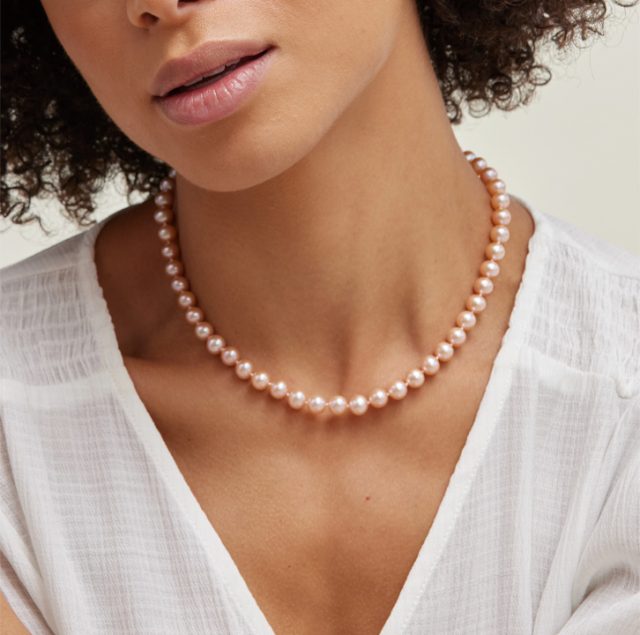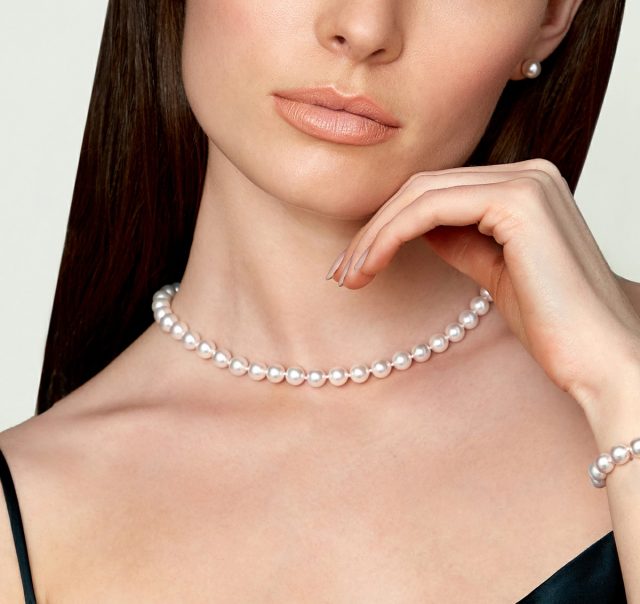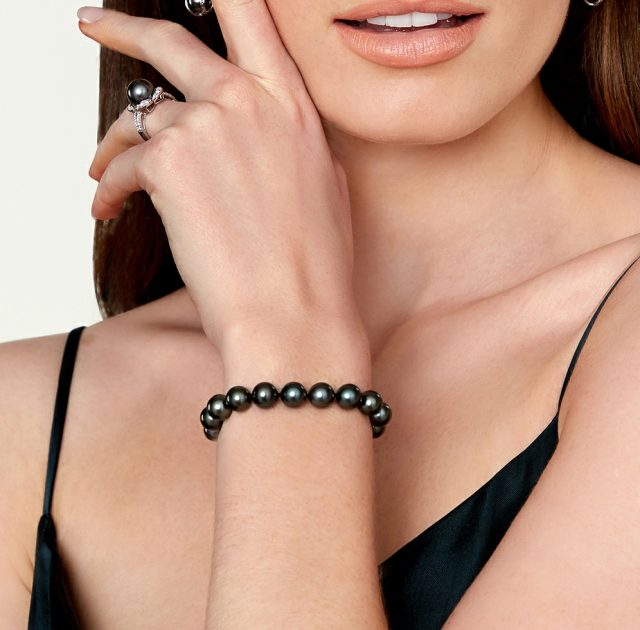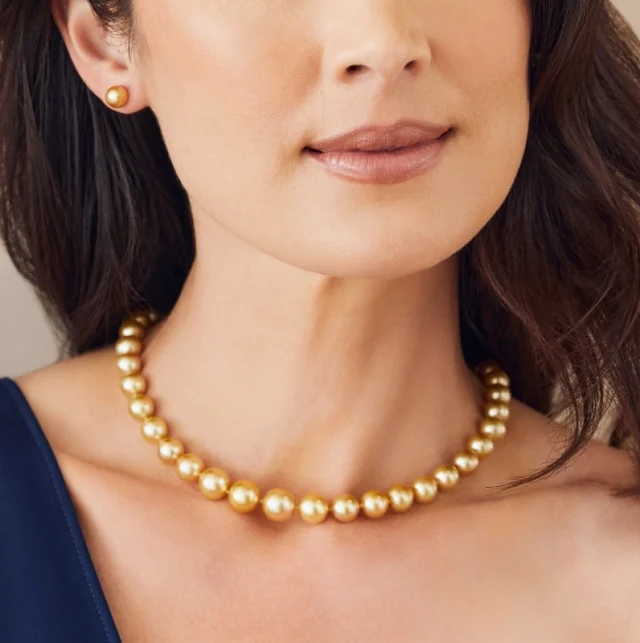Ready to invest in a beautiful piece of pearl jewelry, but don’t know where to start? You’re in the right place! We know that the world of pearls can be a lot to take in, so we’ve put together this pearl buying guide to help steer you towards the best jewelry for you.
No matter your personal style, budget, or the type of jewelry you’re looking for, read on to learn how to buy pearls.
Many people may overlook this step, but taking some time to get acquainted with the vast and inspiring world of pearl jewelry is a great start. Whether it’s browsing fashion magazines or blogs, scouring Pinterest, or beginning to research jewelry brands, you can begin to align your style inspiration and budget realities.
The main thing is to remember to not make any hasty purchases yet, however tempting it may be! Making sure you’re informed about pearl quality and value is the most important step in buying pearls.
Pearl jewelry can range from being relatively accessible, to costing millions of dollars! This is why it helps to have perused a few jewelry websites already.
No matter where you are on the budget spectrum, defining how much you can spend is a simple and important step. Remember that factors like pearl quality, frequency of wear, and how formal a piece should all be considered when setting your budget.
Your budget may range from around $100 for a pair of simple freshwater pearl earrings, to the many tens of thousands for a south sea pearl necklace. The good news is that however much you have to spend, there’s a genuine pearl jewelry piece out there for you!
Where you buy your pearls from, especially online, is an important decision. Some dodgier sellers, like unverified second hand sales, may try and pass off freshwater or even imitation pearls as a higher quality pearl. Or, from more traditional jewelers, you may recieve pearls of excellent quality, but with a vastly inflated price.
Finding the balance of quality, transparency, and value can be tricky, so here are some things to look out for:

Now you’ve defined your budget and chosen your jeweler, it’s time to choose your pearl type. You may already know that you want a south sea pearl, or you may just know that you want a white pearl. Either way, choosing your pearl type will help you narrow down your search. Make sure to consider factors such as budget, color and shape, and whether you’re shopping for an everyday piece or pearls for fancy occasions.
There are four types of pearls commonly used for jewlery. In ascending price order:

These pearls come in a huge range of shapes, sizes, and colors. Round freshwater pearls look almost identical to Akoya pearls but are less expensive, with a strand ranging from $50 to $2,000.
These are the classic round, white pearls. They were the first pearls ever to be farmed, and are a little bit smaller. A strand of Akoya pearls can cost from $300 to more than $10,000.


These exotic pearls have uniquely dark colors. Depending on their size and quality, a strand of Tahitian pearls can cost from $500 to more than $25,000.
These are considered the most valuable, and are also the largest pearl variety on the market. A strand of South Sea pearls can range from $1,000 to over $100,000.

Once you have an understanding of the different types of pearls, the varying color options, and the price ranges for each type, it’s time to make some decisions! From classic white to modern black pearls, there is a pearl for any style.
When it comes to how much a pearl is worth, the GIA (Gemological Institute of America) considers seven factors: color, shape, type, surface quality, luster, and a set of pearls match. These will all be taken into consideration to give each pearl a grading, ranging from A to AAAA (or A to Hanadama for Akoya pearls). Each pearl type has its own specific grading guidelines, so let’s take a look.
| A | AA | AAA | AAAA | |
|---|---|---|---|---|
| Information | Low Quality Freshwater representing the bottom 60% of pearl harvest. (Not Sold at The Pearl Source) | Medium-Grade Freshwater representing top 20% of Harvest. Commonly found at Jewelry Stores and major department stores (Not Sold at The Pearl Source) | High-Grade Freshwater representing the top 10% of a pearl harvest. Found in Finer Jewelry Stores. | Very High-Grade Freshwater representing the top 1-2% of a pearl harvest. |
| Surface | Heavy blemishing with only a 50% or less clean surface. | Minor to medium blemishing with a 70-80% clean surface. | Minor blemishing with at least 90% of the pearl surface clean. | Very minor to no blemishing with at least 95% of the pearl surface clean. |
| Luster | Poor | Medium | High | Very High |
| Shape | Off Round | Off Round | Near Round to Round | Round |

| A | AA | AA+ | AAA | Hanadama | |
|---|---|---|---|---|---|
| Information | Low Quality Japanese Akoya representing the bottom 50% of pearl harvest (Not Sold at Pearl Source | Medium-Grade Japanese Akoya representing top 60% of Harvest. Commonly found at jewelry stores and Major Department Stores (Not Sold at Pearl Source) | High-Grade Japanese Akoya representing the top 5-10% of a pearl harvest. Found in Finer Jewelry Stores. | Very High-Grade Japanese Akoya representing the top 1-5% of a pearl harvest. | Gem Quality Japanese Akoya Pearls representing the highest 1% of a pearl harvest. Accompanied by a numbered certificate by the Pearl Science Laboratory of Japan. |
| Surface | Heavy blemishing with only a 50% or less clean surface. | Minor to medium blemishing with a 70-80% clean surface. | Minor blemishing with at least 90% of the pearl surface clean. | Very Minor to no blemishing with at least 95% of the pearl surface clean. | 99% or cleaner pearl surface with either very minor to no blemishes visible. |
| Luster | Poor | Medium | High | Very High | Superior |
| Nacre | Thin | Medium | Thick | Very Thick | Very Thick |
| Shape | Round/Off Round | Round | Perfectly Round | Perfectly Round | Perfectly Round |
| A | AA | AAA | AAAA | |
|---|---|---|---|---|
| Information | Low Quality Tahitian representing the bottom 50% of pearl harvest (Not Sold at Pearl Source) | Medium-Grade Tahitian representing top 60% of Harvest. Commonly found at jewelry stores and Major Department Stores (Not Sold at Pearl Source) | High-Grade Tahitian representing the top 5-10% of a pearl harvest. Found in Finer Jewelry Stores. | Very High-Grade Tahitian representing the top 1-5% of a pearl harvest. |
| Surface | Pearls having flaws on at least 60% of the pearl surface, with 20% containing deep imperfections. | Flawless pearl on 40% of its surface, with the remaining 50% having minor imperfections and 10% containg deep flaws. | Flawless pearl on at least 80-85% of its surface, with remaining 15-20% containing only minor imperfections with one or two deep imperfections. | Flawless pearl on at least 95% of the pearl surface, with 5% concentrated imperfections. |
| Luster | Poor | Medium | High | Very High |
| A-D Grading System | “D” Quality | “C” Quality | “A/B” Quality | “A” Quality |
| A | AA | AAA | AAAA | |
|---|---|---|---|---|
| Information | Low Quality South Sea representing the bottom 50% of pearl harvest (Not Sold at Pearl Source | Medium-Grade South Sea representing top 60% of Harvest. Commonly found at jewelry stores and Major Department Stores (Not Sold at Pearl Source) | High-Grade South Sea representing the top 5-10% of a pearl harvest. Found in Finer Jewelry Stores. | Very High-Grade South Sea representing the top 1-5% of a pearl harvest. |
| Surface | Pearls having flaws on at least 60% of the pearl surface, with 20% containing deep imperfections. | Flawless pearl on 40% of its surface, with the remaining 50% having minor imperfections and 10% containg deep flaws. | Flawless pearl on at least 80-85% of its surface, with remaining 15-20% containing only minor imperfections with one or two deep imperfections. | Flawless pearl on at least 95% of the pearl surface, with 5% concentrated imperfections. |
| Luster | Poor | Medium | High | Very High |
| A-D Grading System | “D” Quality | “C” Quality | “A/B” Quality | “A” Quality |
It’s now time to put your pearl knowledge to action, and do some shopping! And with so many styles of pearl necklaces, bracelets, earrings, and rings on the market, you can use this as an opportunity to show off your personal style.
And for more inspiration, take a look at our Bestsellers and Shop The Look pages, or shop by jewelry type. Pearls are a classic, timeless way to elevate any outfit, and buying pearls is an investment that you get to wear for life.
We hope this pearl buying guide will help you navigate this exciting purchase — happy shopping!
Signup now and receive an email once I publish new content.